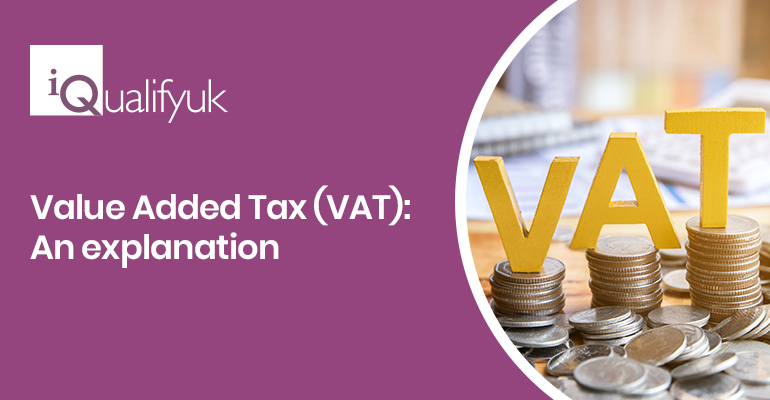An explanation of Value Added Tax (VAT)
September 7, 2023 2023-09-07 13:02An explanation of Value Added Tax (VAT)
Value Added Tax, or VAT as it is usually called, was introduced in the UK in 1973 as a tax in common across the European Union (EU) countries. It is charged on the value added to goods and services and is administered by HM Revenue and Customs (HMRC). In the UK all businesses with a turnover (from April 2015) of more than £82,000 per tax year (of everything sold which isn’t VAT exempt) must be registered for VAT with HMRC. The turnover figure is normally increased annually in the budget. Once registered the VAT registration number must be quoted on the company’s invoices and other business documents.
They have changed over the years, but there are currently three rates. These are standard (20%), reduced (5%) and zero (0%). In addition some goods and services are exempt or are outside the system.
Examples of goods and services in the different rate categories
Standard rate = drinks, biscuits, chocolate, electrical goods, delivery charges, food consumed on the premises, etc.
Reduced rate = children’s car seats, utilities (domestic electricity, gas, fuel), smoking cessation products etc.
Zero rate = bike helmets, books, canned and frozen food, children’s clothes, food (eggs, fish, fruit, meat, poultry, tea, coffee, salt, sandwiches), prescription medicines, public transport fares, newspapers, magazines etc.
Exempt = antiques, burials, cultural events, education, financial services, health services (doctors, dentists, opticians), membership subscriptions, gambling, sports activities
Outside = goods and services sold outside the EU, goods and services supplied by an unregistered supplier, statutory charges (eg MOT, congestion charge), tolls (public owned bridges, roads, tunnels), charity donations etc.
The full list is available at www.gov.uk/guidance/rates-of-vat-on-different-goods-and-services.
Businesses pay the amount of VAT collected on sales (output tax) less the amount of VAT charged to them (input tax) on all taxable supplies bought in. If the amount of input tax is greater that the output tax then the business claims a refund of the difference from HMRC. The business pays the tax due (assuming it is not claiming a refund) through submitting a VAT Return.
VAT Returns
A business usually submits a VAT Return to HMRC every 3 months. This period of time is known as the ‘accounting period.’
The Return records things for the accounting period such as:
- the total sales and purchases
- the amount of VAT owed
- the amount of VAT that can be reclaimed
- what the VAT refund from HMRC is
A business must submit a Return even if it has no tax to pay or reclaim. The return is sent electronically to HMRC.
Small businesses may alternatively use a flat rate scheme which allows them to calculate VAT payable as a percentage of sales. There is therefore no need to calculate input and output VAT or even to identify the VAT element in individual transactions. The threshold to join the scheme is £150,000 and the threshold to leave the scheme is more than £230,000 (as of April 2015). This simple scheme is designed to cut down on the paperwork for small businesses.
A tax on the final consumer
VAT is a tax which is paid by the final consumer. An individual buying a TV for £360 will pay £300 for the TV and 20% of that (£60) as VAT. Prices must be always quoted to the public as including VAT (with the VAT element shown on the receipt). However, the tax is paid through the production and distribution process. Thus:
(1) Supplier of materials
Sells materials for £100 plus £20 VAT = £120
(2) Manufacturer
Builds TV (i.e. adds value) and sells for £220 plus £44 VAT = £264
(3) Shop
Adds on margin and sells for £300 plus £60 VAT = £360
HMRC therefore receives £20 from the supplier, £24 from the manufacturer (£44 less £20) and £16 from the shop (£60 less £44), a total of £60.
The VAT exclusive price can be calculated by dividing the amount by 1.20 or 1.05 (depending on whether the rate is 20% or 5% respectively) so, for example, £240 divided by 1.20 means that the item costs £200 and the VAT is £40.
Evasion
The UK government loses revenue through evasion and fraud. Evasion, which is illegal, is when businesses pay less than they should through understating sales or overstating payments, or by not charging when they should do through, for example, cash-in-hand jobs.
VAT account
A VAT registered business should keep a Value Added Tax Account as part of the bookkeeping system in the general ledger. This records:
Debits (input tax)
- VAT on purchases
- VAT on fixed assets (except cars)
- VAT on expenses
- VAT on sales returns
Credits (output tax)
- VAT on sales and/or services
- VAT on purchases returns
- VAT on the sale of fixed assets
Recent Posts
- iQualify UK is excited to announce our recent accreditation with Pearson
- iQualify UK honoured with Queen’s Award for Enterprise: International Trade
- How is Leadership Related to Management in a Contemporary Business Environment?
- How Do Barriers to Change Influence Leadership Decision-Making?
- How Does Change Impact on an Organisation’s Strategy and Operations?



